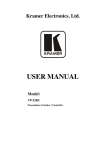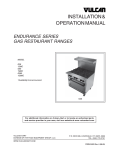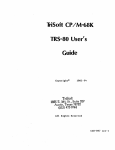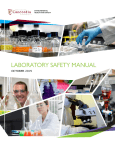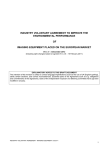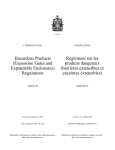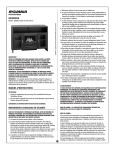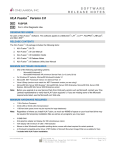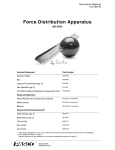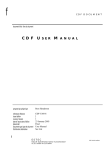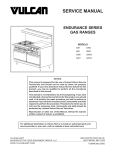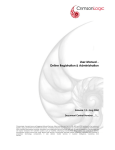Download R&TTE Directive Guidance document for Manufacturers
Transcript
R&TTE Directive (The new regulation on radio and telecommunications terminal equipment) Guidance document for Manufacturers, Representatives and Persons responsible for placing on the market on: Responsibilities Declaration of Conformity User Information Product Marking (version 2001.02) (Belgian Institute for Postal services and Telecommunications) February 2001 page 1 of 18 BIPT R&TTE directive Guidance for Manufacturers and Persons responsible for placing on the market on Responsibilities, DoC, User Information and Product Marking Table of Contents TABLE OF CONTENTS ......................................................................................................................................................2 1. OBJECTIVES.................................................................................................................................................................3 2. GENERAL OBSERVATIONS ..................................................................................................................................3 3. RESPONSIBILITIES ...................................................................................................................................................4 3.1 3.2 3.3 3.4 3.5 4. THE MANUFACTURER..............................................................................................................................................4 THE AUTHORISED REPRESENTATIVE .....................................................................................................................4 IMPORTER / PERSON RESPONSIBLE FOR PLACING ON THE MARKET ..................................................................5 DISTRIBUTOR............................................................................................................................................................5 A SSEMBLER, INSTALLER AND USER......................................................................................................................6 DECLARATION OF CONFORMITY (DOC)......................................................................................................6 4.1 REFERENCES TO “DECLARATION OF CONFORMITY”..........................................................................................6 4.2 OBSERVATIONS ........................................................................................................................................................6 4.3 CONTENT OF THE “DECLARATION OF CONFORMITY”........................................................................................7 4.3.1 The original DoC...................................................................................................................................................7 4.3.2 The DoC with each product .................................................................................................................................8 5. USER INFORMATION...............................................................................................................................................9 5.1 5.2 5.3 6. A LL APPARATUS.......................................................................................................................................................9 TELECOMMUNICATIONS TERMINAL EQUIPMENT ...............................................................................................9 RADIO EQUIPMENT ................................................................................................................................................10 PRODUCT MARKING............................................................................................................................................. 12 6.1 PRODUCT IDENTIFICATION MARKING..................................................................................................................12 6.2 PRODUCT CONFORMITY MARKING.......................................................................................................................12 6.2.1 All apparatus ............................................................................................................................................... 12 6.2.2 Telecommunication Terminal Equipment............................................................................................... 13 6.2.3 Radio Equipment......................................................................................................................................... 13 6.3 OVERVIEW OF THE PRODUCT MARKING..............................................................................................................16 7. ADDITIONAL USEFUL INFORMATION ........................................................................................................ 17 8. MODIFICATIONS - CONTACTS ........................................................................................................................ 18 February 2001 page 2 of 18 BIPT R&TTE directive 1. Guidance for Manufacturers and Persons responsible for placing on the market on Responsibilities, DoC, User Information and Product Marking Objectives The objective of this document is to give guidance to • manufacturers and their authorised representatives, • importers, • distributors and • persons responsible for placing R&TTE apparatus on the EEA-market about their responsibilities and on how to fulfil the requirement of the R&TTE directive • to supply information to the user, • to draw up a written declaration of conformity (DoC1) and • to affix the correct markings on • the product or its data plate • the packaging and • the accompanying documents It must be clear that this document is only for information and has no binding legal value. It is however in line with the provisions of the R&TTE directive, other Community provisions, the views expressed in TCAM (the Committee under the R&TTE directive) and the interpretation given in the latest version of the “blue guide”2. The Commission is of the opinion that no or only a very limited specific guidance document is needed and that sufficient information can be found in the “blue guide” and in the text of the Directive. The BIPT is however of the opinion that the range of subjects covered by the “blue guide” is so wide that it is justified to try to bring all elements in one document. No guidance is given in this document on the notification obligation for some radio equipment and on the conformity assessment procedures. This is a living document that will be adopted from time to time as further guidance becomes available. The format in which the information is to be presented is left to the person who has to provide the information. 2. General observations • It is the responsibility of the manufacturer or the person responsible for placing the apparatus on the market to provide the “necessary” information. • Critical information should also figure on the packaging (“prominently displayed”). • It is clear that the elements intended for the user should be clear, easy to understand and easy to access. As a consequence the documents, which accompany the product, and the critical information on the packaging must be in the language of the country or region where the product is intended to be sold and used. 1 The abbreviation “DoC” is widely used to indicate the “Declaration of Conformity” 2 Doc. Certif. 98/1 “Guide to the implementation of directives based on new approach and global approach” version 1999. The “blue guide” February 2001 page 3 of 18 BIPT R&TTE directive Guidance for Manufacturers and Persons responsible for placing on the market on Responsibilities, DoC, User Information and Product Marking • The manufacturer or his authorised representative must affix the CE-marking. • CE marking indicates that the product in question has been designed and manufactured in conformity with all applicable provisions of the Community directives providing for its affixing. • If the product falls in the scope of more than one directive which provide for the affixing of the CE marking, then the CE-marking indicates conformity with the essential requirements of all these directives. • If the apparatus falls also in the scope of other directives which also provide for the affixing of the CE marking, and for which a transitional period is still in force, the CE marking shall indicate that the apparatus fulfils the provisions only of those directives applied by the manufacturer. In this case, the particulars of those directives, as published in the Official Journal of the European Communities, must be given in the documents, notices or instructions required by those directives and accompanying such products. • Article 6.1 of the directive states that the requirements of the R&TTE directive should be fulfilled when the apparatus is properly installed and maintained. So information on installation and maintenance should be included in the user info if necessary. • Although nothing is said in the directive itself, the user should be informed on what he can expect as being the normal behaviour of his equipment. 3. Responsibilities Guidance on the responsibilities is given in the chapter 3 of the “blue guide”. Some of the statements are given below: 3.1 The manufacturer • A manufacturer is the person who is responsible for designing and manufacturing a product with a view of placing it on the Community market on his own behalf. • The manufacturer has an obligation to ensure that a product intended to be placed on the Community market is designed and manufactured, and its conformity assessed to the essential requirements in accordance with the provisions of the applicable New Approach directives. • The manufacturer must always retain the overall control and have the necessary competence to take the responsibility for the product. 3.2 The authorised representative • The manufacturer may appoint any natural or legal person to act on his behalf as an authorised representative. • The authorised representative must, in order to be able to act on behalf of the manufacturer, be established inside the Community. • The authorised representative is explicitly designated (written mandate) by the manufacturer, and he may be addressed by the authorities of the Member States instead of the manufacturer with regard to the latter’s obligations under the directive in question. February 2001 page 4 of 18 BIPT R&TTE directive Guidance for Manufacturers and Persons responsible for placing on the market on Responsibilities, DoC, User Information and Product Marking • The manufacturer remains generally responsible for actions carried out by an authorised representative on his behalf. • Commercial representatives of the manufacturer, whether or not established inside the Community, are not to be confused with the authorised representative according to the directives. • An authorised representative cannot modify the product on his own initiative in order to bring it into line with the applicable directives. 3.3 Importer / Person responsible for placing on the market • An importer (= a person responsible for placing on the market) – in the meaning of New Approach directives – is any natural or legal person established in the Community who places a product from a third country on the Community market. • The natural or legal person, who imports a product into the Community may, in some situations, be considered as the person who must assume the responsibilities placed on the manufacturer according to the applicable New Approach directives. • The importer must ensure that he is able to provide the market surveillance authority with the necessary information regarding the product, where the manufacturer is not established in the Community, and he has no authorised representative in the Community. • The importer must ensure, in order to fulfil his responsibilities, that a contact with the manufacturer can be established. • The Legal Services of the Commission stated during TCAM 3: "Where an importer takes the initiative to affix the CE mark or where he declares that a product can be used in other Member States as those identified by the manufacturer, he becomes responsible for the product and declares himself as the legal entity, on which the tasks of the manufacturer fall.". 3.4 Distributor • A distributor is to be considered as any natural or legal person in the supply chain who takes subsequent commercial actions after the product has been placed on the Community market. • The distributor should know, for instance, which products must bear the CE marking, what information (e.g. the DoC) has to accompany the product, what are the language requirements for users instructions or other accompanying documents, and what is a clear indication of the product being non-compliant. • The distributor may not supply products that he knows or should have presumed, on the basis of information in his possession and as a professional, not to be in compliance with the legislation. • The distributor should inform the national surveillance authority on non-compliant products and product risks, and co-operate in actions taken to avoid or minimise these risks. • The distributor must also be able to identify the manufacturer, his authorised representative in the Community, the importer or the person who has provided him with the product in order to assist the surveillance authority in its efforts to February 2001 page 5 of 18 BIPT R&TTE directive Guidance for Manufacturers and Persons responsible for placing on the market on Responsibilities, DoC, User Information and Product Marking receive the declaration of conformity and the necessary parts of the technical documentation. 3.5 • Assembler, installer and user Where an assembly, an installation or other manipulations may have an impact on maintaining the compliance of the product, the person responsible for such manipulations must ensure that they do not cause a non-compliance with the essential requirements. 4. Declaration of Conformity (DoC) 4.1 References to “Declaration of Conformity” 1) R&TTE Article 6.3 – first part Member States shall ensure that the manufacturer or the person responsible for placing the apparatus on the market provides information for the user on the intended use of the apparatus, together with the declaration of conformity to the essential requirements. 2) R&TTE ANNEX II The manufacturer or his authorised representative established within the Community must affix the CE marking to each product and draw up a written declaration of conformity. 3) R&TTE ANNEX III The manufacturer or his authorised representative established within the Community or the person responsible for placing the apparatus on the market must declare that these (=essential radio test suites) tests have been carried out …. 4) R&TTE ANNEX IV The technical documentation described in point 4 of Annex II and the declaration of conformity to specific radio test suites described in Annex III must form a technical construction file. 5) R&TTE ANNEX V The manufacturer must affix the marks referred to in Article 12(1) to each product and draw up a written declaration of conformity. 6) EN45014 “General criteria for supplier’s declaration of conformity” “DoC = Statement by the supplier, claiming under his sole responsibility that a product, process or service is in conformity with a specific standard or other normative document” 7) “Blue guide” Chapters of relevance: 5.4 EC declaration of conformity & 7 CE marking 4.2 Observations Although EN 45014 speaks about a “suppliers’ DoC”, the conformity assessment procedures foreseen in the R&TTE directive state that it is the manufacturer (Annex February 2001 page 6 of 18 BIPT R&TTE directive Guidance for Manufacturers and Persons responsible for placing on the market on Responsibilities, DoC, User Information and Product Marking V – full quality assurance) or the manufacture or his authorised representative (Annex II – internal production control) who draws up a written DoC. With a DoC the manufacturer or his authorised representative declares that an apparatus complies with the applicable essential requirements. The DoC must ensure that the product satisfies the essential requirements of the directive. The DoC must be kept for at least ten years from the last date of manufacture of the product. The DoC must be made available to the surveillance authority immediately upon request. Moreover, the R&TTE directive requests that each product is accompanied by the DoC. The standard EN 45014 has been drawn up with the objective of providing the general criteria for the suppliers’ DoC, and it can also be used as guidance. According to this European standard the DoC may take the form of a document, a label or equivalent, and should contain sufficient information to enable all products covered by it to be traced back to it. If the DoC has to accompany the product (this is the case for the R&TTE directive), it must be based on the “blue guide” and the Belgian law, drawn up as a minimum in the language of the country (or region) of use. If necessary, a translation has to be provided by the manufacturer, his authorised representative or the distributor. Additionally, a copy of the declaration in the original language has to be supplied. 4.3 Content of the “Declaration of Conformity” 4.3.1 The original DoC Concerning the layout (format) it is recommended to apply Annex A of EN45014 "General criteria for supplier’s declaration of conformity" (see also ISO/IEC Guide 22:1996) together with the elements mentioned in chapter 5.4 of the “blue guide”. As a minimum the following information must be provided in the declaration: • the name and address of the manufacturer and if applicable of his authorised representative issuing the declaration (contact information); • the identification of the product (name, type or model number, and any relevant supplementary information; e.g. lot, batch or serial number, sources and numbers of items); • the referenced standards or other normative documents (e.g. national technical standards and specifications) in a precise, complete and clearly defined way; • all supplementary information that may be required (e.g. grade, class), if applicable; • a statement that all essential radio test suites have been carried out (applicable for transmitting radio-equipment – see Annex III of the R&TTE directive); • a statement that the product is in conformity to all applicable essential requirements of all applicable directives; • the date of issue (of this Declaration of Conformity); • signature and title or an equivalent marking of an authorised person; • the statement that the declaration is issued under the sole responsibility of the manufacturer and, if applicable, his authorised representative. It is recommended to also include: February 2001 page 7 of 18 BIPT R&TTE directive • • • Guidance for Manufacturers and Persons responsible for placing on the market on Responsibilities, DoC, User Information and Product Marking a reference to the conformity procedure which has been followed; the identification number of the notified body when it has been involved in the conformity assessment procedure (see below), preferably also his name and address; the name and address of the person who keeps the technical documentation in the Community. Annex VII.3 of the R&TTE directive states : “The CE marking … must be affixed to … , and to the accompanying documents. As a consequence the CE marking, including the notified body number, must also figure on the DoC. Due to the fact that articles 20.2 and 20.3 of the R&TTE directive state that the provisions of the EMC directive and the low voltage directive no longer apply to equipment falling within the scope of the R&TTE directive, only reference to the R&TTE directive should be made for the EMC and LVD aspects. The list of (harmonised) standards complied with should be mentioned on the DoC and should cover all aspects, including the LVD requirements (Art 3.1.a), the EMC requirements (art 3.1.b), the spectrum requirements (art 3.2) and eventually art 3.3 requirements. The DoC must therefore explicitly refer to the R&TTE Directive. If the alternative procedures of the LVD and/or EMC Directives were used, the DoC for the R&TTE Directive may contain a reference to the declarations under the LVD and/or EMC Directives. 4.3.2 The DoC with each product Among other things, article 6.3 of the R&TTE Directive imposes the obligation to joint to each product the DoC. This seems to cause some practical problems for the manufacturers. This issue was discussed during TCAM 5 and 6, where the following common position was taken : Ø The original DoC must be directly or indirectly available to the user; Ø An informal declaration (see below) concerning the conformity with the R&TTE Directive must at least be provided with the product, in the language of the region where the product is sold and for which it is intended. For the provisions of the original DoC, reference is made to the previous heading. If the content complies with EN 45014, it can be assumed that the DoC complies with the requirements. However, other layouts are not excluded. The informal declaration appears in the user's manual or in any other document that is joined to the product, and its content is equivalent to : “[Name of the manufacturer] declares that the apparatus [type of apparatus] complies with the essential requirements and other relevant provisions of Directive 1999/5/EC" If the original DoC is not joined to the product itself, this declaration has to be completed by a web address where the DoC can be consulted. The BIPT insists upon either a direct link to the web page where the DoC can be found, or a mention of an e-mail address where the DoC can be retrieved freely.website The organisation "Declarenet" tries to set up an internet business to government (B2G) service via the web site http://www.DeclareNet.com in order to offer manufacturers, in an easy way, the opportunity to make the DoC of their product available to the users and the authorities responsible for the market surveillance. February 2001 page 8 of 18 BIPT R&TTE directive Guidance for Manufacturers and Persons responsible for placing on the market on Responsibilities, DoC, User Information and Product Marking The above-mentioned arrangements of course do not detract other obligations imposed on the manufacturer (intended use, geographical restrictions,...). 5. User information 5.1 All apparatus Source: Article 6.1 – first part … that apparatus … only if it complies with the appropriate essential requirements identified in Article 3 and the other relevant provisions of this directive when it is properly installed and maintained and used for its intended purpose. Source: Article 6.3 – first part Member States shall ensure that the manufacturer or the person responsible for placing the apparatus on the market provides information for the user on the intended use of the apparatus, together with the DoC to the essential requirements. Source: Article 6.3 – fourth part For all apparatus such information shall be prominently displayed. Consequences The manufacturer or the person responsible for placing an apparatus on the market has the obligation to provide the necessary information. Where an assembly, an installation or other manipulations may have an impact on maintaining the compliance of the product, clear instructions should be provide to the person responsible for such manipulations (user) in order to ensure that these manipulations do not cause a non-compliance with the essential requirements. “Prominently displayed” means that the attention of a candidate buyer is drawn to the fact that additional information (e.g. in the user manual) is provided which gives details on the intended use and that he should consult this information before buying. A clear statement on the packaging can be suitable for this. 5.2 Telecommunications Terminal Equipment Source: Article 6.3 – third part Where it concerns telecommunications terminal equipment, such information shall be sufficient to identify interfaces of the public telecommunications networks to which the equipment is intended to be connected. Consequences In addition to the items mentioned under 5.1 the following items should be considered for telecommunications terminal equipment. The information on the intended use of the apparatus shall be sufficient to identify the applicable interfaces of the public telecommunication network, to which the equipment is intended to be connected. This information is essential for the buyer to be able to connect the apparatus to the appropriate interfaces. A candidate buyer should be able to be aware about the intended interfaces before buying. In order to be declared (by the manufacturer) as intended to be connected to a specific public telecommunications network, the telecommunications terminal February 2001 page 9 of 18 BIPT R&TTE directive Guidance for Manufacturers and Persons responsible for placing on the market on Responsibilities, DoC, User Information and Product Marking equipment must be declared compatible with some properly defined features or services offered by the public network operator. The manufacturer has to list the different features supported by his terminal out of the features declared available by the public network operator in his interface description. In order to be able to use the telecommunications terminal equipment for its intended purpose, the accompanying user information should give a list of intended public network interfaces including the supported options in the terminal. This means also that the user may only connect the product to the interfaces listed. As stated in article 4.1 of the R&TTE directive, the Commission shall establish the equivalence between the notified interface. If this has been done, then the information can refer to this classification to declare the intended interface of the appropriate type. It will however still be necessary to list the supported options in the terminal if the classification by the Commission allows (slightly) different implementations. During TCAM 4 it was decided to publish only an informal list of equipment classes. This list will be published on the TCAM server (see below). 5.3 Radio Equipment Source: Article 6.3 – second part Where it concerns radio equipment, such information shall be sufficient to identify on the packaging and the instructions for use of the apparatus the Member States or the geographical area within a Member State where the equipment is intended to be used … … and shall alert the user by the marking on the apparatus referred to in Annex VII, paragraph 5, to potential restrictions or requirements for authorisation of use of the radio equipment in certain Member States. Source: ANNEX VII Marking of equipment referred to in Article 12(1) Where appropriate it (equipment class identifier in the marking) must include an element intended to provide information to the user that the apparatus makes use of radio frequency bands where their use is not harmonised throughout the Community. Observations Different elements can be found in the text above: • Information on the geographical area where the equipment is intended to be used (not placed on the market) is required; • The marking on the apparatus should contain information for the user on 3 subjects: • potential restrictions (no legal use); • requirements for authorisation (legal use after obtaining an authorisation – individual license); • product makes use of radio frequency bands the use of which is not harmonised. It has to be noted that these requirements apply to all radio equipment irrelevant if the use is harmonised or not (using harmonised frequency bands or not) and/or conformity assessment based on harmonised standard or not. February 2001 page 10 of 18 BIPT R&TTE directive Guidance for Manufacturers and Persons responsible for placing on the market on Responsibilities, DoC, User Information and Product Marking Consequences In addition to the items mentioned under 5.1 the following items should be considered for all radio equipment. • The information on the intended use shall be on the packaging and in the “instructions for use” of the apparatus. • The marking on radio-equipment shall alert the user of: • potential restrictions of use in certain Member States • requirements for authorisation of use of the radio equipment in certain Member States • the use of frequency bands the use of which is not harmonised. The Commission has, during TCAM 4, taken a decision regarding the element in the marking mentioned above. More on this subject in the chapter “product marking". For practical reasons the detailed information on the intended use, the possible restrictions and the requirements for authorisation of use, are allowed to be in the accompanying documents if this is clearly indicated on the packaging (prominently displayed). The “instructions for use” should include a table or other statement indicating where (country, countries or regions) the radio-equipment is intended to be used and if an authorisation (e.g. individual or general licence) is needed to legally use the radio equipment3. It is necessary that possible restrictions be stated in the language of the region where the restriction applies and in the language of the region where the product is sold. For the intended use of radio equipment, such information shall be sufficient to identify the Member States or the geographical area within a Member State where the equipment is intended to be used. The Commission stated during TCAM 3 that manufacturers should indicate, even for receiving equipment, where it is intended to be used. For receiving equipment, which is not allowed to be used for other reasons then those covered by the Directive (e.g. speed radar-warning apparatus), he should in general terms indicate, that usage may be constrained. The marking must include an element intended to provide information to the user that the apparatus makes use of radio frequency bands where their use is not harmonised throughout the Community. The “instructions for use” should as a consequence include a statement that the apparatus makes use of radio frequency bands where their use is not harmonised throughout the Community. In this case details on the authorised frequency, channel usage, power and other technical characteristics applicable in the different countries or regions should be stated in the “instructions for use” 3 The format how this information is to be provided is still unclear. This was already discussed in AHG- B, but no consensus could be reached (positive and/or negative list). If an agreement is reached, this should be included here. If no agreement is reached the format is left to the person responsible for providing this information. The market surveillance authorities could also provide helpful information. February 2001 page 11 of 18 BIPT R&TTE directive Guidance for Manufacturers and Persons responsible for placing on the market on Responsibilities, DoC, User Information and Product Marking 6. Product marking 6.1 Product identification marking Source: Article 12.4 Apparatus shall be identified by the manufacturer by means of type, batch and/or serial numbers and by the name of the manufacturer or the person responsible for placing the apparatus on the market. Observations The manufacturer has the obligation to identify the apparatus. He is however not obliged to put his (brand)name on the apparatus. In consultation and in agreement (contract) with the person responsible for placing the product on the market, the person responsible for placing the apparatus on the market (reseller) can allow the manufacturer to put the resellers (brand)name on the product. The responsibility for the conformity of the apparatus remains however with the manufacturer. The product information should contain sufficient information to make a clear link with the DoC covering that product and supplied with the product. Remark: The manufacturer or his authorised representative must draw up the DoC. The reseller must be able to give information on the real manufacturer 6.2 Product conformity marking 6.2.1 All apparatus Source: Article 8.1 … apparatus bearing the CE marking referred to in Annex VII, which indicates its conformity with all provisions of this directive, including the conformity assessment procedures … Source: Article 12.1 – except part 2,-second sentence Apparatus complying with the relevant essential requirements shall bear the EC conformity marking referred to in Annex VII. It shall be affixed under the responsibility of the manufacturer, his authorised representative within the Community or the person responsible for placing the apparatus on the market. Where the procedures identified in Annex III, IV or V are used, the marking shall be accompanied by the identification number of the notified body referred to in Article 11(1). Any other marking may be affixed to the equipment provided that the visibility and legibility of the CE marking is not thereby reduced. Source: Annex VII – section 1, 2, 3, 4 1. The CE conformity marking must consist of the initials "CE" in the usable known layout. If the CE marking is reduced or enlarged, the proportions must be respected. 2. The CE marking must have a height of at least 5-mm except where this is not possible on account of the nature of the apparatus. 3. The CE marking must be affixed to the product or to its data plate. Additionally it must be affixed to the packaging, if any, and to the accompanying documents. February 2001 page 12 of 18 BIPT R&TTE directive Guidance for Manufacturers and Persons responsible for placing on the market on Responsibilities, DoC, User Information and Product Marking 4. The CE marking must be affixed visibly, legibly and indelibly. Source : “blue guide” Chapter of relevance : 7 CE marking Observations Some of the observations on the CE marking are already stated under item “2. General observations” and are not repeated. If a notified body is involved during the conformity assessment procedure (Annex III, IV or V) then the identification number of that notified body must accompany the initials “CE”. The CE marking on the product may not be omitted nor be moved to the packaging or accompanying documents on purely aesthetic grounds. The requirement for visibility means that the CE marking must be easily accessible for market surveillance authorities. It must be visible for distributors, users and consumers. The requirement for indelibility means that the CE marking must not be removed from the product without leaving traces noticeable under normal circumstances. However, this does not mean that the CE marking must form an integral part of the product. Sometimes several notified bodies are involved. In these situations several identification numbers follow the CE marking. The affixing of the identification number of a notified body indicates that the notified body assumes some responsibility. 6.2.2 Telecommunication Terminal Equipment Observations For telecommunication terminal equipment that is not also radio equipment, the directive does not specify additional marking other than the CE mark. If the manufacturer has used one the conformity assessment procedures foreseen in Annex IV or V, then the identification number of that notified body involved must accompany the initials “CE”. Attention must be drawn to the fact that the performance of (voluntary) tests by a laboratory that is also a notified body, is not enough to include the number of this notified body in the EC marking. According to Annex IV, the complete technical construction file has to be submitted to the notified body, after which the notified body can give an opinion within 4 weeks. 6.2.3 Radio Equipment Source: Article 4.1 – last sentence … the Commission shall establish the equivalence between notified interfaces and assign an equipment class identifier, details of which shall be published in the Official Journal of the European Communities. Source: Article 6.3 Where it concerns radio equipment, … shall alert the user by the marking on the apparatus referred to in Annex VII, paragraph 5, to potential restrictions or requirements for authorisation of use of the radio equipment in certain Member States. February 2001 page 13 of 18 BIPT R&TTE directive Guidance for Manufacturers and Persons responsible for placing on the market on Responsibilities, DoC, User Information and Product Marking Source: Article 12.1 – part 2, second sentence Radio equipment shall in addition be accompanied by the equipment class identifier where such identifier has been assigned. Source: Annex VII.5 The equipment class identifier must take a form to be decided by the Commission in accordance with the procedure laid down in Article 14. Where appropriate it must include an element intended to provide information to the user that the apparatus makes use of radio frequency bands where their use is not harmonised throughout the Community. It must have the same height as the initials "CE". Observations The concept of equipment class identifier is linked with radio equipment, irrelevant if harmonised standards are used during the conformity assessment procedure, irrelevant if the equipment uses frequency bands the use of which is harmonised or not and irrelevant if there are requirements for authorisation of use or not. It is clear from the second sentence of the second part of article 12.1 (see above) that the equipment class identifier is to be regarded as being an integral part of the CE marking. This can only be applied if the equipment class has been assigned. If the apparatus makes use of radio frequency where their use is not harmonised an element of the equipment class identifier must attract the users attention to this fact 4 (“information element”). The “information element” which forms an integral part of the equipment class identifier added to the conformity marking contains information for the user on 3 subjects: • potential restrictions (no legal use); • requirements for authorisation (legal use after obtaining an authorisation – individual or general license); • product makes use of radio frequency bands the use of which is not harmonised. It is clear that the “information element” must refer to the “instructions for use”. In consultation with the Member States, the Commission identified two main categories of radio equipment during TCAM 4. The first class consists of all radio equipment that can be used without any restriction in the whole Community. No sign was attributed to this class for the identification of the equipment class (= no supplementary marking). The second class consists of any other radio equipment, i.e. radio equipment for which there is some sort of restriction in the use. The packaging and the users manual must contain more information about this. The following graphic symbol was adopted as the sign for indicating the class : (“alert sign”) 4 It is possible that this “information” element will be accepted as the only equipment class identifier. The description of this “information” element is to be inserted here after a decision by the Commission on this subject. February 2001 page 14 of 18 BIPT R&TTE directive Guidance for Manufacturers and Persons responsible for placing on the market on Responsibilities, DoC, User Information and Product Marking The exact graphic layout of the information sign was established in the “Commission Decision of 6/4/2000 establishing the initial classification of Radio Equipment and Telecommunications Terminal Equipment and associated Identifiers”. This decision is also published in the Official Journal of the European Communities. For this class of equipment, this sign is part of the CE marking and must consequently appear on the product, the packaging and the joined documents. In many cases, the identification number of the notified body that intervened in the conformity procedure will have to be mentioned between the "CE" symbols in the known form and the sign mentioned above. It is to be expected that no other signs than the "information sign" will be defined for identifying the equipment class. The Commission has published an informal, non binding list on the TCAM R&TTE web site. In consultation with the member states an attempt will be made to transfer second class equipment to the first class. The list published on the TCAM web site is the basis for the BIPT to determine whether an apparatus has to be provided with the information sign or not. The manufacturers have an interest in consulting that list regularly. Only when they are convinced that their equipment belongs to the first class, the information sign can be omitted in the marking. The following equipment can be considered as first class equipment: Ø terminal equipment attached to fixed networks Ø non-transmitting radio equipment (receive-only equipment) Ø radio equipment, which transmits only under the control of a network Ø radio transmitters, the use of which is totally harmonised in the member states (DECT). Although nothing is said in the directive itself, it is assumed that the equipment class identifier and the “information element” in particular, will be helpful to allow market surveillance authorities to identify those radio equipment that is allowed to be used only in certain geographical areas. February 2001 page 15 of 18 BIPT R&TTE directive 6.3 Guidance for Manufacturers and Persons responsible for placing on the market on Responsibilities, DoC, User Information and Product Marking Overview of the product marking Telecommunications Terminal Equipment (non radio) Conformity Procedure Marking Annex II (internal production control) Annex IV (technical construction file) or Annex V (full quality assurance) Conformity Procedure Radio Equipment The "use" of frequency band is harmonised is not harmonised Annex II (internal production control) (receive-only radio equipment) Annex III (Annex II + specific product tests) (use of harmonised standards) Radio tests in Harmonised Standard Radio tests not all in Harmonised Standard Annex IV (technical construction file) or Annex V (Full Quality assurance) NB nr = number of the notified body that was involved during the conformity procedure (possibly more than one). February 2001 page 16 of 18 BIPT R&TTE directive 7. Guidance for Manufacturers and Persons responsible for placing on the market on Responsibilities, DoC, User Information and Product Marking Additional useful information Information on the R&TTE directive can be found on the server of the European Commission: http://europa.eu.int/comm/enterprise/rtte/index.htm The following sections are available on: http://europa.eu.int/comm/enterprise/rtte/infor.htm: General information on the Directive 199/5/EC State of play of implementation of the Directive Equipment classes and Equipment class identifiers Harmonised standards Notified bodies Contact points within Member States Links to websites of Member States and documents The chapter “General information on the Directive 1999/5/EC” immediately available at http://europa.eu.int/comm/enterprise/rtte/gener.htm contains important information: Introduction to the R&TTE Directive Interpretation of the Directive Frequently asked Questions ERO’s website http://www.ero.dk/ (item Frequency Plans - National Allocation Tables) contains links to the national frequency plans. These frequency plans are needed by manufacturers of radio equipment and are to be respected. It is advised to consult these sites regularly. General information on the principles of the directives based on the new and the global approach can be found at: http://europa.eu.int/comm/enterprise/newapproach/legislation.htm “blue guide” (in different languages) http://www.eotc.be/ “blue guide” (version 1999) – “new” and “global approach” The clarification documents written by the BIPT are grouped on the BIPT website in: http://www.bipt.be/rtte. The general information document of the BIPT contains, in addition to general information, additional explanations concerning supplementary essential requirements which well-defined equipment has to meet. Manufacturers of course have to reckon with this. February 2001 page 17 of 18 BIPT R&TTE directive 8. Guidance for Manufacturers and Persons responsible for placing on the market on Responsibilities, DoC, User Information and Product Marking Modifications - contacts Description Date Edition one Version 2000.01 Classification of radio equipment Insertion of the “information element” in the marking Overview of the marking Version 2000.05 Additional guidance on DoC Layout “alert sign” in the marking New links in chapter “additional useful information” Version 2000.11 Additional clarification on DoC with each product Notified body number in the marking of terminal equipment Reference to additional essential requirements Version 2001.02 DoC on the internet (DeclareNet) Equipment Classes CE marking for receive-only equipment Remarks and questions can be addressed to the BIPT ( +32 (0)2/226 88 88 4 +32 (0)2/223 11 28 & http://www.bipt.be/rtte + [email protected] February 2001 page 18 of 18 1999.12 2000.01 2000.05 2000.11 2001.02 author: Eric Colpaert BIPT


















